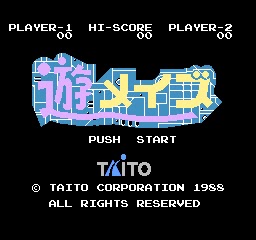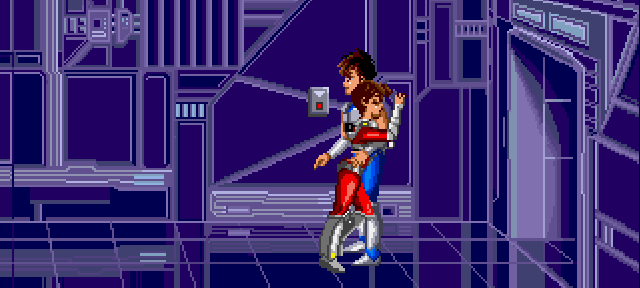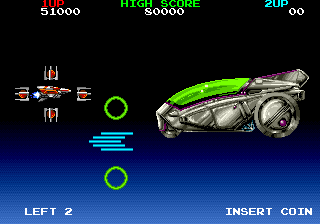So now that we’ve covered the basics and the gameplay up through the end of Raimais, it’s time to investigate some of the other interesting stuff surrounding this game! Hopefully if you’ve read this far, you’ve been inspired to play Raimais… or perhaps take a deeper look at it! And since I know the way you arcade-gaming types think, I’ve prepared answers to some questions you likely have.
Should I play Raimais to attempt a single credit clear? Hell yes, go for it — but be warned, it is very difficult. The best way to get a 1cc is a deathless run with warps, which will remove a lot of stages that will pose problems, but making even one mistake will put the 1cc in jeopardy.
Should I play Raimais as a speedrun game? I think this would work out very well, but for the reason mentioned above, it would probably be the least marathon safe game in existence. Routing would be super fun to do since you’ve got a lot of choices on where to go, and there’s a good amount of strategy to be devised in the individual levels.
Should I play Raimais for score? NO NO NO NO NO DO NOT DO THIS
Playing Raimais as a score game is an exercise in misery. The key to high scores is dying at least once early on (so you don’t get warps), then milking the hell out of stages where you have lasers and/or Norganizers. In laser levels, you just keep blasting enemies as they respawn for more points, but it’s an excruciating grind – most of the game’s points come from energy plate pickups rather than enemy kills, so every car you blow up adds a piddling amount to your score which only becomes meaningful after several minutes of repeated takedowns. Norganizer milking’s a bit more fulfilling, since it involves letting them drop as many high-value plates as possible, but it’s no less tedious (and far more dangerous). There’s a score replay up on Nico Nico Douga if you want to see what it looks like. Note how many times grinding has to be cut away from.
But even after I’ve said so much already, there’s still so much more about this game that’s worth highlighting! How about we start with…
The Soundtrack
I can’t believe I’ve gone this long and have barely discussed the music of Raimais! The composer behind the game is Masahiko Takaki, aka MAR — a man responsible for a whole bunch of awesome Taito arcade soundtracks. Seriously, if you haven’t heard Night Striker, Rastan Saga, or Full Throttle, I suggest listening to them posthaste.
Raimais doesn’t have much music, but like Rastan, it really doesn’t need much because its main theme is just so good. It would be even better if it didn’t reset every time you entered a new stage, because the only way you’re hearing all of it in-game is to either spend a long time on a level or die a lot. While the other songs in the game don’t quite match up to this one (the theme for the last few stages is pretty great, but the second theme suffers from being far too short of a loop), Raimais is still one of the most memorable games in MAR’s soundtrack portfolio. The soundtrack is on iTunes, so go grab it (and thank Zuntata Records for not being jerks about Youtube takedowns).
Debug Mode
A little while back, I asked ultra-talented arcade code-digger Suddendesu (visit that site, seriously, lots of cool stuff) if he’d have a moment to look at Raimais and see if he could find any remnants of debug or another unused modes. It didn’t take him long before he reported finding a debug feature that enables slo-mo, pausing, a stage select, and invulnerability.
Debug mode is triggered by the game having a certain value in memory while the “allow continues” dipswitch is set to On. With debug mode on, the Player 1 Start button enables pause, while holding it down makes the game run in slow motion. Pressing Player 2 start resumes the game at normal speed.

Pressing P2 start during play, however, brings up a stage select menu. Pressing P1 button 1 increments the round, while pressing button 2 increments the “zone.” Zone, as your probably guessed, is the color variant for each round: 0 is red, 1 is green, 2 is blue, 3 is gray. 4 will take you a Reverse Round boss encounter. Interestingly, the “4” in each round set is not a specific stage like the others: it immediately warps you to whatever the pre-set Reverse Round boss for your current stage is. Several stages have no way to access a Reverse Round, but still have bosses set: if you fight a boss using the debug code, you’ll get an encounter with Gum Can that includes a Chris Houlihan Room-style error message.
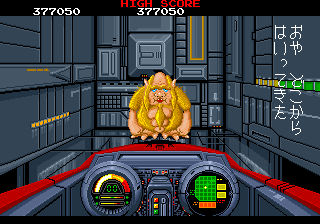
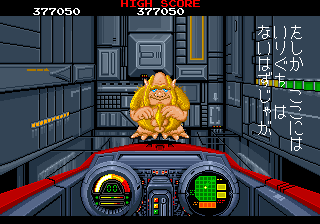
“Hmmm? How did you get here? I was sure there weren’t any entrances….”
This mode also contains an invincibility feature. By setting the default starting lives dipswitch to its maximum value, the game ignores collision with enemies and the shots fired by bosses. However, you can still die with invulnerability on if you get caught in shutters or if a Norganizer gets lasers and fires them at you.
If you want all the technical nitty-gritty (and the MAME cheats to play around with the code for yourself), it’s all over on Suddendesu’s site. Have fun!
Cinematics (and refusals)
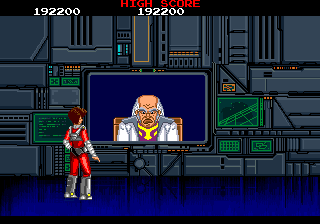
I’ve talked up the game’s voiced cinematics a bit, but I’m sure that some of you are curious as to what’s being said during these cutscenes. Some of the dialogue’s a little tough to make out since I’m not a native Japanese speaker and the sample rate isn’t particularly great, but with a little help from friends, I’ve managed to translate (most of) these scenes into English.
Scene #1:
With deaths: “This is just the beginning, but you look like you’ve seen better days. Good luck, you’ll need it! Hahaha…”
No deaths: “And how does the elder sister find this?”
“Easy.”
“Well then, let’s make things a bit more interesting for her.”
Scene #2:
With deaths: “(the first part of this is tough to make out — nobody else I asked could understand it well, either). I hope you’re prepared…”
No deaths: “You’ve done well to get here. Congratulations. Here’s a little present to you from us.
Scene #3
is where one of the game’s more memorable moments — at least, to Japanese retro players — takes place.
“Why don’t you give up on getting your brother back? You can join us…”
To which Rika responds very curtly:
“I refuse.”
Her exact words are “Okotowari shimasu,” literally “I refuse.” And players (in Japan) seem to really like and remember this bit!
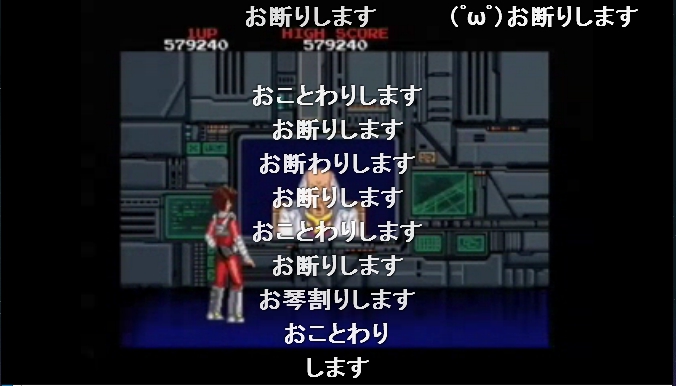
A Nico video capture (of a video that has recently vanished) of the scene in question, with “OKOTOWARI SHIMASU” Nico user comments covering the screen.
Kishibe Rohan would be proud.
From here, the scene changes very slightly depending on if you have or haven’t taken a death:
With deaths: “Impudent brat! You’re going to regret that!”
No deaths: “Impudent brat! But your bravado ends here!”
The Voice Actors
Looking at promotional media for the game in Japanese magazines at the time, a lot was made of the fact that the game had cinematics and voice acting with “professional seiyuu.” I mean… yeah, as I’ve already said, it was pretty damn impressive for 1988! But the voice actors in question were never named in those articles… so just who were they?
The answer is possibly buried deep in Raimais’s mess of a credit sequence. While roles for each name listed aren’t given, there are two names that devoted fans of Japanese voice actors might recognize.
The first is Taro Arakawa, a voice actor who played mostly supporting roles in several anime and dubs of English-language animation and films who passed away in 2012. Looking at his list of credited roles, he tended to play older men, so odds are good that he was probably Mr. Molto’s voice.
The other voice actor listed is Rika Fukami, which is probably an alternate romanization of the name Rica Fukami. Rica Fukami, if the link hasn’t made it obvious, has done a whole lot of stuff. If this Rika Fukami is the same person — which is highly likely — then Raimais was one of her earliest leading roles. In fact, it might not be a stretch to assume that she may have influenced Rika Midorikawa’s name… though the two Rikas use different kanji.
Fukami was indeed active in voicework during the mid-late 80s, though was mostly doing small supporting parts in anime up until her big breakout role of Sailor Venus in Pretty Soldier Sailor Moon in 1991. At that, point she became much higher profile. Nowadays her anime and videogame roles aren’t quite as prominent as her work dubbing big-name stars in Hollywood films and television, but she’s still in the business of voicing anime and game characters.
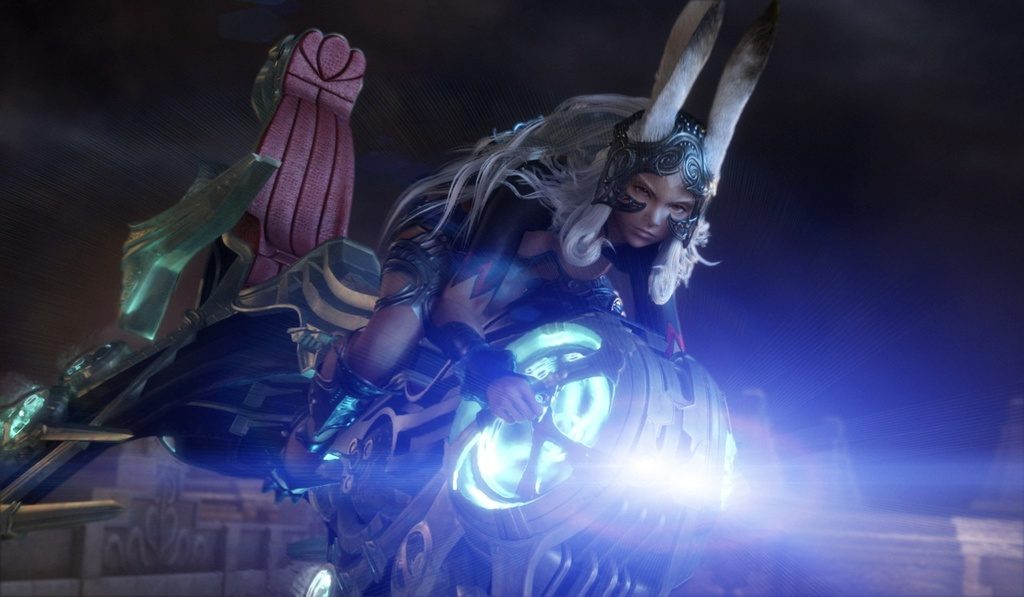
Most importantly, she is the voice of Fran in Final Fantasy XII. I really hope we’re correct in assuming she played Rika, because voicing two of my favorite awesome bike-riding game women is just too damn perfect.
Unused Stuff
Like many arcade games, there’s development material and unused content buried in the ROMs of Raimais that can’t be seen in the game itself. Some of this stuff is already on the game’s TCRF page (the existence of which is all me, baby), though in the course of writing this feature, I’ve found even more things that aren’t on there (yet) — and it hints that the ending sequence was perhaps planned to be more elaborate (and potentially even more dark).
First off is some music. The game was planned to have title screen and stage clear jingles, but for whatever reason, both go unused.
Title theme
Stage clear jingle
If they had to get rid of the stage clear jingle, it would have been nice if they didn’t reset the music track after every round, too.
Now we’ve got voices! Lots of them! The first voice clip in the sound ROM is Mr. Molto, with a noticeably different (and better) sound quality than most of the later clips:
“This is a test version.”
Not hard to figure this one out — it was likely used at a location test version of the game.
What’s far more interesting, though, are a set of three files much later on from a different male voice than Mr. Molto.
“I’m impressed, you actually made it here. On the shortest course with no mistakes, no less.”
“Now the farce comes to an end. Time to die, sister.”
“Stupid sister, you should have given up when you had the chance…”
Sandwiched in between the first and second of these voice samples in the ROM is Rika’s startled “Makoto!” cry from the bad ending. Taken together, these clips spell out a very disturbing scenario: Rika comes in to find her brother has been observing her performance, he’s been one of the bad guys all along, and he now wants her dead. The first clip indicates that this could have been a special ending for playing the game on a single life and getting all of the warps.
If I had to wager a guess as to why this was cut, I’d say that it was probably seen as too big of a dick move. Imagine completing the very difficult task of getting through the game on one life, scoring all of the warps, and playing perfectly to the end… only for the brother you worked so hard to rescue to turn on you. Yeah, that would be traumatic.
Weirdly, both these three clips and the above “test version” clip were featured among the game’s music tracks on an old game music CD, Taito DJ Station G.S.M. 5, which is how many Japanese players came to knew of their existence. They’ve been the subject of speculation for quite some time — and only now has this speculation been confirmed, as we’ll see in the next section.
Those aren’t the only unused voices, though! There are even more that can be heard using Bridge M1, such as…
“You’re a clever one. You seem to be avoiding all of my traps…” (EDIT: This is actually used, sort of. Details a bit further down.)
“If you’re so keen on saving your brother, then why are you stalling!?”
“It doesn’t matter. This race ends today. I’ve already set a self-destruct bomb in this building.”
“There’s no time! Just hurry up and…!” (part of this is really hard to make out)
While the first one could be used in a lot of situations (It’s located next to Mr. Molto’s sound clips from the ending sequence), the latter three are the last voice samples in the ROM, and there’s an urgency to them that suggests yet another possible ending where the facility is going to explode, and Rika and Makoto must escape while Mr. Molto taunts them. A bit happier than potential fratricide, I’d say.
Unused graphics
A wonderful individual by the name of Mark J was inspired to dig into Raimais’s graphics after reading these pieces. He discovered some very interesting stuff, including sprites from one of the missing endings that the voice files would have corresponded to.
In particular, Makoto had a LOT of sprites that went unused, some for inexplicable reasons.
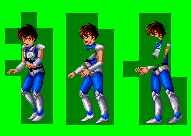
Here are some of the first few unused Makoto sprites. The leftmost image has him in some sort of surprise/concern pose, while the other two have him looking very happy… even though he appears to be missing quite a few pixels. It’s not too hard to figure out what they were intended for, however — they’re the sprites that were originally planned to be used in the ending, when Rika and Makoto meet up again and they embrace.
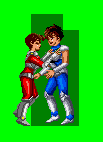
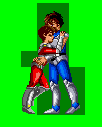
Here’s how the sprites should look together when properly layered.
Instead, in the final game, Makoto just kind of… stands there, seemingly devoid of affection, while Rika hugs him. I’m not sure why they didn’t go with the original sprites they drew for this ending — maybe they didn’t want to block Makoto’s face? In any case, if you look carefully at Rika’s ending sprite (check this article’s header!), she’s actually missing some pixels in her waist area where Makoto’s hand is supposed to be. Whoops!
 Here’s another set of unused sprites, with Makoto falling to his knees. His left hand in the rightmost sprite looks really weird, as though the artists expected something to be layered over it. Could this have been a scrapped reaction to Rika’s potential death? It’s a possibility!
Here’s another set of unused sprites, with Makoto falling to his knees. His left hand in the rightmost sprite looks really weird, as though the artists expected something to be layered over it. Could this have been a scrapped reaction to Rika’s potential death? It’s a possibility!
 And then there’s this among Makoto’s sprites. This basically confirms the reveal the potential ending that the audio files hinted at, with Makoto tearing off his amazing disguise of Mr. Molto to reveal that he was a villain all along!
And then there’s this among Makoto’s sprites. This basically confirms the reveal the potential ending that the audio files hinted at, with Makoto tearing off his amazing disguise of Mr. Molto to reveal that he was a villain all along!
(I really love how this looks exactly like a villain reveal in your average Scooby-Doo episode. He just yoinks the whole thing off!)
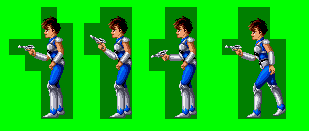


If that didn’t confirm that the devs intended an ending with a Rika and Makoto showdown, then these sprite sets certainly do: Makoto walking forward with a gun in the same way Mr. Molto would in the other endings, along with a collapsing animation. These aren’t just the sprites from the normal bad ending flipped, either: Makoto always wields the gun right-handed, so these are completely redrawn.
So there you have it. The ending with Makoto trying to kill his sister existed at one point, was far enough along to have graphics and voicework done for it, and was ultimately scrapped. A near 30-year-old mystery is now solved!
There aren’t any sprites of Rika with any alternative weaponry or means of defense, so it seems likely that she’d once again need the Light Mirror in order to survive this.
![]()
Gum Can has several facial expressions for his conversations stored in the ROM, most of which have his looking friendly and chill, but buried in the graphics are these odd expressions of him talking to you while looking angry. These intrigue me: was it possible to do something to piss him off at some point during development? Maybe there was actual conversion interaction planned where you could give bad responses? We may never know.
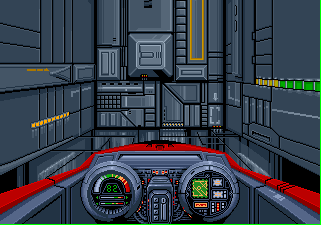
Also, the screen where you encounter Gum Can actually has some graphics retouching. Take a close look at the gauges in the circles here — they look a little different, don’t they?

That’s because they’re actually drawn over with these sprites in-game. Why? Who knows, somebody probably thought they looked better. (And they were right.)
Most of Rika’s sprites are used, though there’s evidence in the ROMs of certain sequences (like her using the Light Mirror) getting touch-ups. (Those are differences of mere pixels, however, and probably more suited to showcase at a place like TCRF.) 
There’s one last sequence of potentially unused Rika art showing her moving backwards while clutching her shoulder, as though she’s injured. I need to confirm this, however: it could be used if she gets low on life in the final sequence, I’ve just never actually been that close to death.
UPDATE: We Found The Secret Ending
Well, it finally happened. Here’s the secret ending to Raimais, as it plays out in-game:
How’d we finally find this? Well, suddendesu (the same swell person who found the Raimais debug mode) did some digging in the CPU instructions. The game checks several variables to determine which ending you get, the most important being whether or not you have the Light Mirror. However, beyond obtaining the mirror, there are two other variables that determine whether or not you can access the secret ending:
- Whether or not you’ve lost any lives: you must do a no-miss clear.
- How many stages you’ve completed: it must be under 17.
This lines up with the dialogue from before: Makoto notes that you didn’t make any mistakes and you took ‘the shortest route.’ However, getting under 17 stages is trickier than it sounds — even more difficult than never taking a death, which is no small feat. Currently, I’m playing and routing to see if this is even possible through normal play, as the most I’ve been able to take the counter down to is 18. (That’s getting all no-death warps along with the optional extra warp in Round 18 Blue — which, may I add, is really hard to get.) The ending may effectively be impossible to reach simply because of the way the conditions are set up, but there’s a chance one could reach it: if a random O panel drop could yield a warp, then it may be feasible, but even if it is, that makes the whole thing dependent on luck/RNG.
In any case, though, this ending is as much of a downer as I thought it would be. Taito did have a proclivity for including unhappy endings in their arcade games, but I’m pretty sure this takes the cake, with the “THE CREDITS” cut at just the right time to leave all of Rika’s resulting psychological trauma to your imagination.
On a side note, there’s another ending that is similarly difficult to obtain, but plays out mostly like the standard bad end. You get this if you don’t have the mirror but have fulfilled the other requirements. The only difference is that Mr. Molto has some changed dialogue. Suddendesu has details on all of the requirements (along with lots of technical notes) along with the MAME cheats to “pick your ending,” so check his writeup out.
Speaking of happy and unhappy endings, though…
The Official(ish) (Possible) Followup
There wasn’t ever a proper Raimais sequel made, but there was a way to see a continuation of the game’s story… in another game entirely.
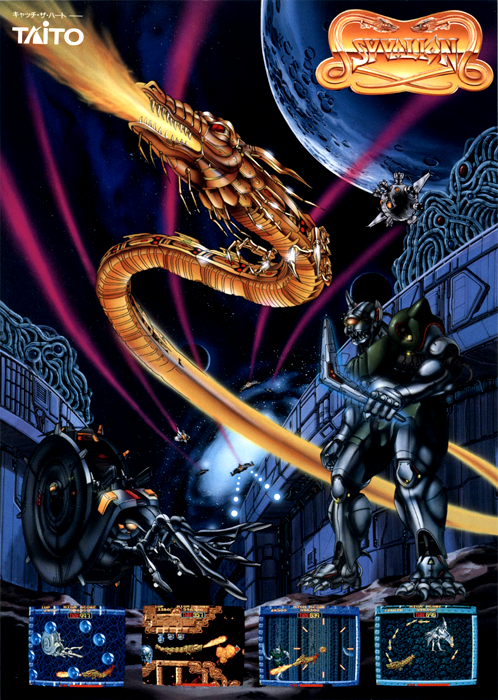
Hey, remember when I wrote about Syvalion, waaaaaaay back when I first started this site? One of the neat things about the game is that the game’s story (presented as text in-between levels) changes from playthrough to playthrough, with your in-game actions having a bit of an influence on where things can go. There are many ways the story can start and end, and some of the paths tie into other Taito games… mostly Darius, but there are three possible endings that actually follow up on Raimais!
In these endings, the pilot of the Syvalion turns out to be none other than Makoto Midorikawa, Rika’s younger brother. This isn’t actually revealed until the very end (since your player character can actually be, well, a lot of different people). After finding the Syvalion in one of the game’s many possible intros and (potentially) discovering a nefarious plot to conquer the planet, Makoto infiltrates the base of the plan’s masterminds.
But seeing this is far from guaranteed. To potentially get on the Raimais path, you’ll have to be given a power-up in the Chapter 2 intro (not reinforcements, though!), then start Chapter 3 with the plot of getting a message from the mysterious enemy leader after defeating the huge mecha: this means you’re on a path for Darius/Raimais-related endings. If you’re on the Raimais path, then around Chapter 4, the mastermind of the planned invasion will appear on the Syvalion’s monitor (that sounds familiar) and state that he has captured the protagonist’s older sister. This can culminate a few chapters later in one of three possible endings:
Ending #83:

I’ve defeated all of the giant mecha! The enemy’s plans have been crushed! There’s the body of the enemy commander. As I remove the mask covering his face, I find myself frozen with shock! It’s my archnemesis Mr. Molto, the one who took my sister’s life! I won’t be able to return together with her… but, by chance, I’ve both carried out my sister’s revenge, and saved the Earth! And so, the fighting ends…
Ending #84:
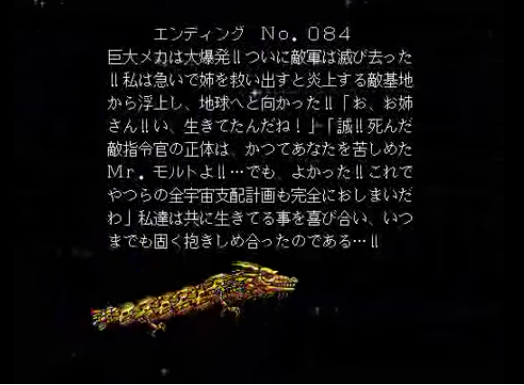
The giant mecha explodes, and the enemy has been destroyed! I quickly escape with my sister from the enemy base. The smoldering wreckage blazes behind us as we fly back towards earth.
“Sister! I- I can’t believe…you’re alive!”
“Makoto… The dead enemy leader’s identity… it’s that bastard Mr. Molto who put you through so much! And… thank god, their keikaku 1 to rule all of space has been ruined!”
We’re both overjoyed that we’re alive, as we hug each other for what seems like forever…!
Ending #85:
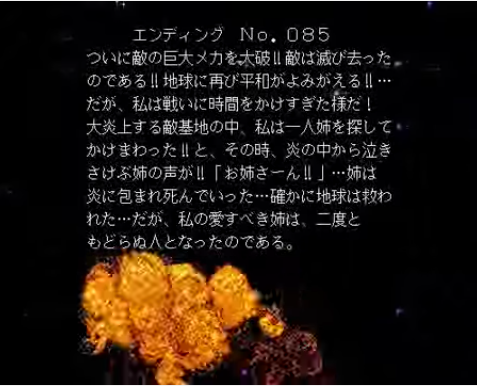
I’ve defeated all of the giant mecha! The enemy’s been destroyed! Peace has returned to Earth! …however, my battle took too long! Inside the burning enemy base, I search frantically for my sister! I hear her screaming voice… “Sister!” I cry out. She perishes in the flames…The planet may have been saved…but, I will not be able to return with my dear sister.
So there you have it! The endings that continue the story of Raimais. Who would’ve thunk that Makoto would grow up to be in charge of a long, lumbering, weirdly-controlling murdermechdragon?
These are my own translations, I should note.2 I think the Europe-only English-language SNES port of Syvalion also has all 100 of the arcade version’s endings… which means the Raimais endings might be in the mix, as well. I’m not a huge fan of the SNES port, though, so it’s something I’ll investigate later when I feel like trying to push myself through it: The random nature of Syvalion makes trying to aim for specific endings pretty tough going. I also wonder — does the version of Syvalion on Taito Legends 2 have weirdly translated versions of these endings, too? I don’t have that edition, but if you’re willing to check (and god bless you, that’s a task to try and get a particular ending without savestates), send your findings along to me!
UPDATE: We’ve found a couple of the “official” English Syvalion endings. From the SNES version, here’s #84:
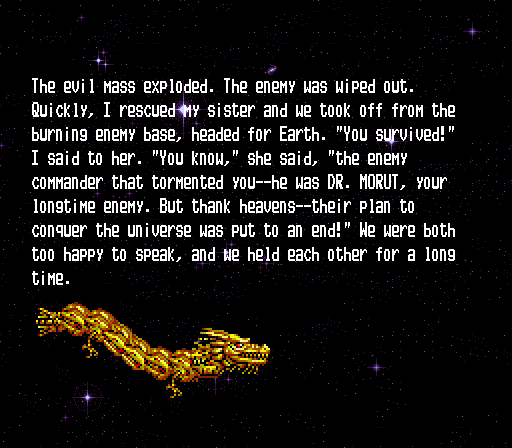
Dr. Morut, huh? That’s what you’re going with? Honestly, though, the translator probably had zero context here — they also didn’t recognize “Makoto” as a proper name instead of a word.
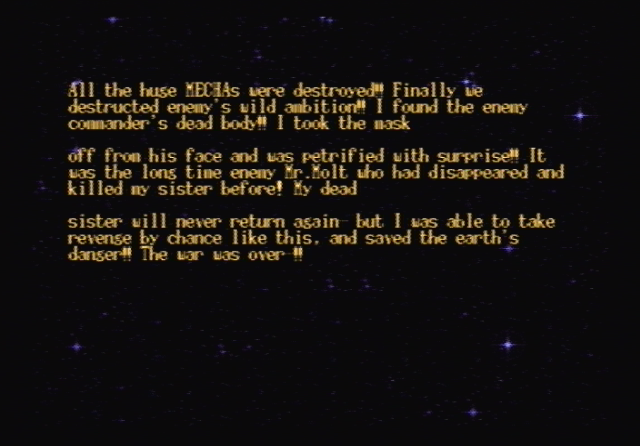
And here’s an offscreen capture of #83 from Taito Legends 2’s Syvalion, capped by friend of the site Ant. It’s definitely got that janky quality you’d expect from an official English Taito arcade release. “Mr. Molt” at least sounds better, but the spacing is, uh, certainly a thing.
(UPDATE: Thanks in part to this article, you can now play this English version of Syvalion in MAME! I’m working to get more of the endings as you read this!)
Honestly, though…. It’s pretty depressing that Rika gets fridged hard in two of these endings — her brother already gets the giant fire-breathing mech spacedragon while she gets stuck with a souped-up scooter. Can’t an awesome retro game girl catch a break at all? Next thing you know, they’ll pretend she didn’t even exi… oh, right, we’ll get to that. SIGH
Another Cameo
The Organizer is an enemy in Megablast, along with a bunch of other Taito characters. That’s all I really want to say because Megablast is awful. So bad, in fact, that I just lifted this image from Ant’s page rather than playing it. They understand.
Raimais World Version
There’s a chance some of you have read through all of this and are utterly puzzled. “What the hell?” you ask. “I didn’t see anything about Rika and her brother, or any of the cutscenes! It just put me straight into a maze from the moment I pressed the start button!”
I’ve got some bad news for you: you’re playing the World version.
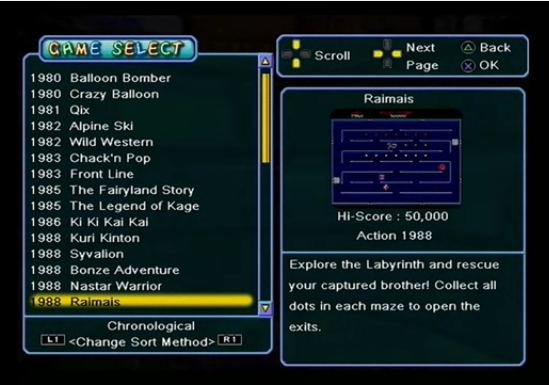
If you’re playing this on Taito Legends 2: I’m sorry.
The World version features all of the Japanese version’s levels, and plays mostly the same: all the the plates, walls, and enemies are in the same places, so there aren’t any jank-ass difficulty alterations in any of the stages. Instead, the changes are in the story sequences: they’re all gone from the game. No introduction, no chats with Gum Can after the Reverse Rounds, no messages from Mr. Molto, and no surprise ending.
 I take that back — you do get to chat with Gum Can, in bits that replace the parts after rounds 4, 12, and 24 where Mr. Molto would message you. He’ll just give you generic words of encouragement, such as the dialogue above warning you about the difficultlies awaiting. There’s a notable gameplay consequence to this: since you don’t have the original cutscenes, that means the warps you’d get from deathless play are gone. You’re doing all 32 stages whether you like it or not, bucko!
I take that back — you do get to chat with Gum Can, in bits that replace the parts after rounds 4, 12, and 24 where Mr. Molto would message you. He’ll just give you generic words of encouragement, such as the dialogue above warning you about the difficultlies awaiting. There’s a notable gameplay consequence to this: since you don’t have the original cutscenes, that means the warps you’d get from deathless play are gone. You’re doing all 32 stages whether you like it or not, bucko!
Weirdly, if you complete a Reverse Round and would be given an item by Gum Can in the Japanese version, you’ll still get it in the World version… but you won’t be told you got it. If you complete a Reverse Round, press the item button in the next stage and hope you get lucky, I guess?
If you’re wondering about the ending…


Well, that sure happened.
Since there’s no story here to speak of, the ending is similarly anticlimactic: a picture of a building (presumably where the labyrinth was) and a message saying that you did well, but you only saw part of the game’s courses, so maybe you should put another coin in and- nah, I’m good, the Japanese ROMset’s sitting right over there.
Remember those unused voices, though? One of them was Mr. Molto talking about how the building was rigged to explode. Could it be that when that idea for an ending was scrapped, the dev team had already drawn art for it… and just decided to make it the World version ending instead? It’s a definite possibility!
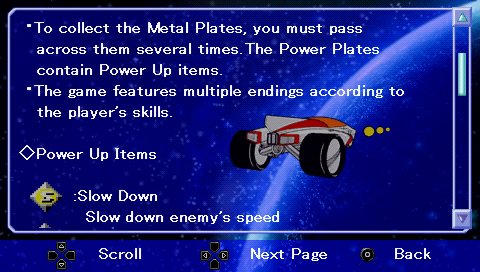
LIES
So the World version is absolutely not the version to play. Removal of the story scenes makes a world of difference: the game is less interesting and missing a key skill element with the warps gone. The question is: why did Taito get rid of them? Perhaps it was the voices, which would need to either be dubbed (not happening) or replaced with text? Then again, Rastan had many more story scenes in its Japanese version, and those were already in English… maybe they thought players just didn’t want story? Hmmm. Perhaps they thought Western players would react badly to an ending where the outcome was bad unless you completed a not-immediately-obvious task? But wait, Bubble Bobble did that, and people liked it just fine. Huh….
I have another theory: common wisdom at the time was that western arcadegoers were mostly young males, and that young males didn’t want to play as women characters. In other words, the story scenes are cut and Rika is never shown because someone thought that Western players would dislike a female lead.
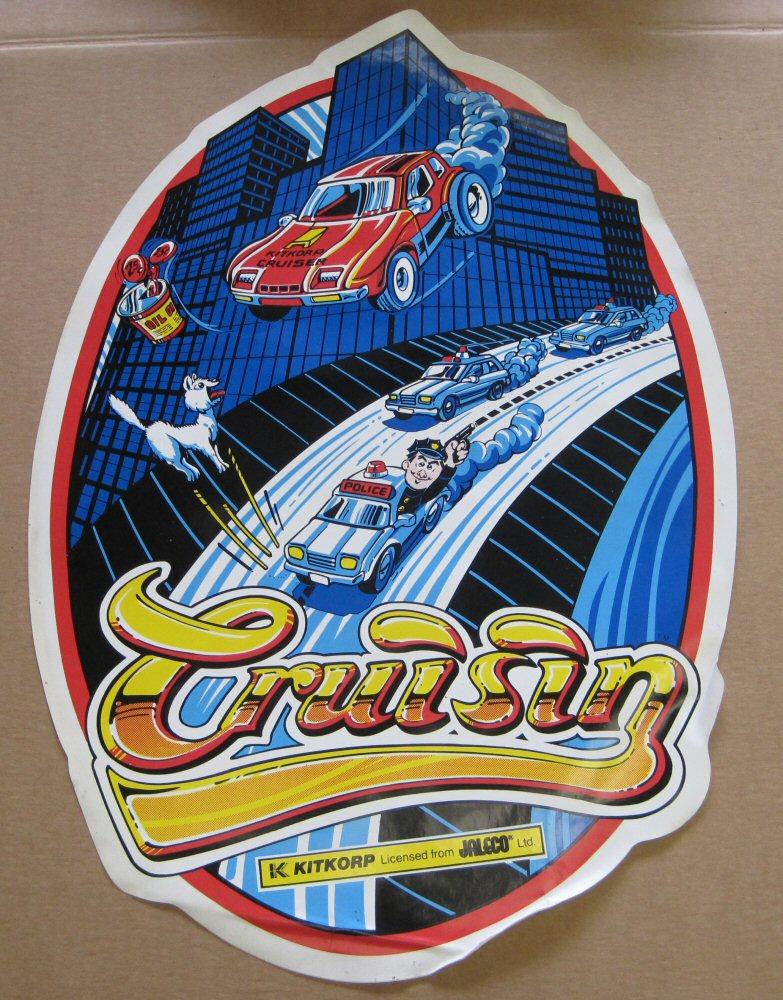
No wimmins driving all the highway here
Now before you bust out screencaps of things I’ve written and draw MSPaint arrows on them to prove my agenda, I’ll point out that there’s a precedent for this sort of thing happening. Games like City Connection and Ninja Princess had their title altered and/or promotional materials adjusted to hide the fact that you’re playing a girl until your coin’s in the machine (and in Ninja Princess’s case, there was a total gender change for the Master System port). Legendary Wings’s heroine got a complete gender swap as well in the first overseas version of the game. Taito wasn’t immune to this nonsense, either: Ptolemy was redrawn in promotional art of The Fairyland Story to be a male elf.
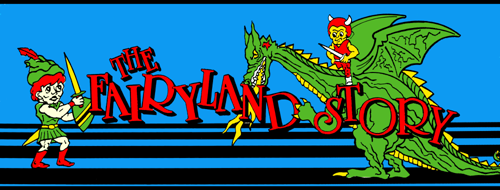 whyyyyyyyyyyyyyy
whyyyyyyyyyyyyyy
So yeah, seeing as how there’s a history of gender hiding/altering happening, I have pretty good reason to believe that at least part of the reason why the story scenes are gone is to conceal that the lead character is a woman. At least we’re past that as an industry, right…?
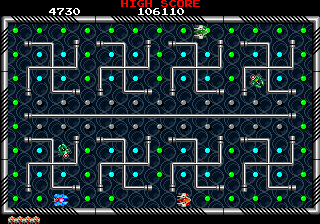
Strangely, even though the export crew dumped all of the story, they overlooked this particular stage in the localization process. Uh, whoops.
A secret code
There’s one hidden code for this game. If you hold Up and the two buttons while pressing start, you’ll see this slide down onto the screen into the middle of the intro:
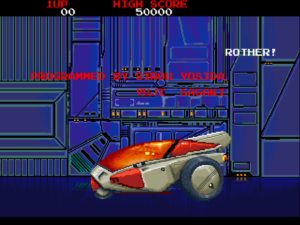
If you’ve triggered this code, the first encounter with Gun Can will also have its text changed to comments about the staff.
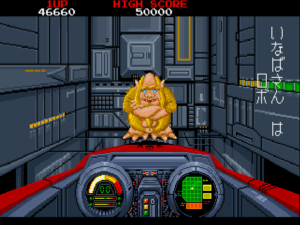
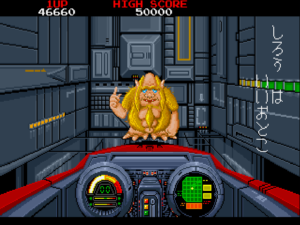
Yeah, it’s basically untranslatable in-jokes. Still, it’s always fun to see this sort of thing turn up in games. The creators had to leave their mark somehow, and given that “The Credits” don’t actually specify most of the particular jobs people worked on this title (and, I’m told, they basically just put in the names of all staff of the Taito Chuo office no matter how involved they were), Shirou… er, Sirou and Yuji got their moments to brag and give some shout-outs.
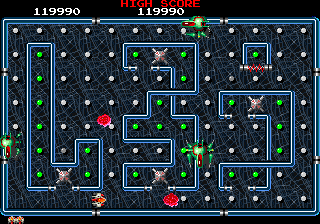
Shirou also put his name in the game in stage 10 Gray, apparently! The walls of this stage form the the hiragana characters “shirou.”
The Arcade Archives Release (11/18/2021)
Raimais has finally received a port to modern platforms! Publisher Hamster has released Raimais on Switch and PS4 as part of their ongoing Arcade Archives releases of classic arcade titles both well-known and obscure. Most of their offerings are pretty straight conversions from the arcade without too much in the way of special features aside from score leaderboards, the Caravan Mode, and the usual array of display/control/dipswitch/etc settings. But the Raimais port is pretty interesting…
For starters, while other Arcade Archives releases have included ROMsets from multiple territories as part of the package, ACA Raimais only contains the Japanese version, essentially refusing to acknowledge the World version exists. That’s not a bad thing, really, though I wish they had found some way to subtitle the dialogue and text.
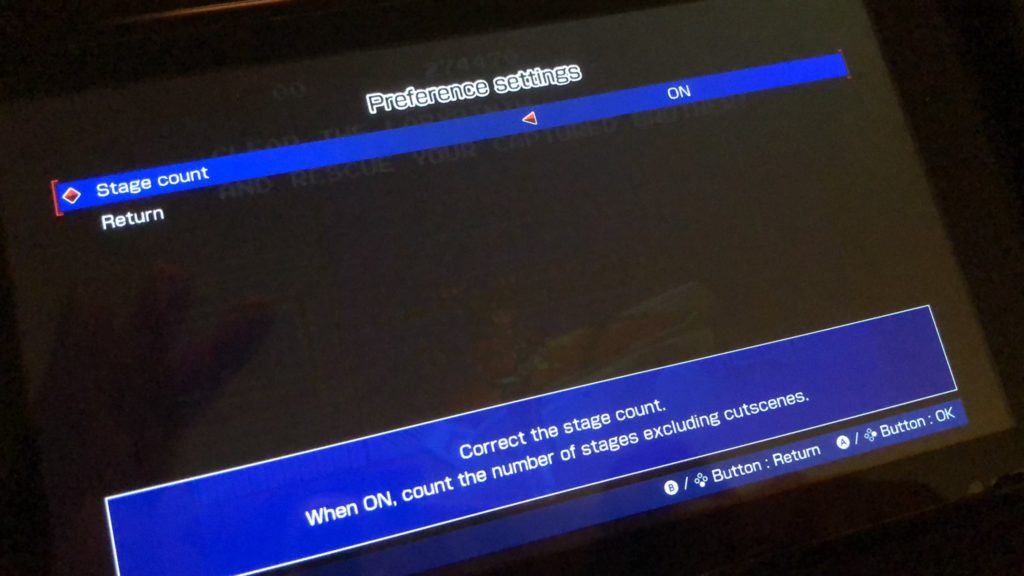
What’s more important, however, is this option here. By setting this to ON, the counter that tracks the number of stages cleared is fixed to exclude cutscenes. And that means that the third “betrayal” ending is now accessible through normal play! Holy crap!
I honestly didn’t think Hamster would go the extra mile to fix this and make that ending possible to get, but I sure am glad they did! Hopefully it carries over to future Raimais re-releases, including its inclusion on the upcoming Egret II Mini cabinet.
Caravan Mode, for those unfamiliar, is a five-mintute timed score attack based on Hudson Soft’s “Caravan” high-score events that would travel across Japan in the 80s and 90s. You play from the beginning for five minutes and aim for the highest score possible in that limited timeframe. It’s a standard feature among all of the ACA games, and some work better in Caravan Mode than others. Raimais… kind of has problems with it.
The big issue is random items. Reverse Rounds offer up the most potential points, so you’ll want to get as many O panels, and no-death warps as you can within the time limit. Basically, you want the random panels you encounter to drop O and C as much as possible, and that potentially means a lot of resetting. Hell, even the first stage has a random panel, so I’ve already spent a fair bit of time “rerolling” for an early Reverse Round. It’d be a lot more fun and fair if the randomness was mitigated, but alas.
Quite simply: if you want to play Raimais on modern consoles, ACA Raimais is… well, maybe not amazing, but it’s both accurate to the original and fixes one of its biggest omissions. Buy it on your platform of choice. Hell, buy it on both. Support Rika for future generations!
Conclusion
So, after writing a small novella’s equivalent of words about Raimais, I think I’ve finally said almost everything I want to about this title. I guess there might still be one lingering question: why on earth do I love this obscure game so much?
Well… a lot of reasons, really. It’s a pretty solid title on its own gameplay merits, and I really dig it even though I’m not a huge fan of dot-crunching games in general — there’s a lot of meat to chew on here in terms of strategy, both for individual stages and for going through the whole game. But I think it’s the story and atmosphere that really make it a treasure. I’m a huge sucker for the 80s sci-fi-anime aesthetic, and Raimais has it in spades: vehicles, giant bug mechs, evil scientists, and that distinctly 80s image of the future!
But then you’ve got the game’s story, and the crazy curveball it throws you at the end. I’d be lying if I said the ending didn’t play a huge part in my affection for Raimais, as I spent literal years attempting to decipher the secret behind the game’s true ending. The presentation also struck me as unique and engaging in for time when cutscenes in games were still a novelty. On top of it all, you had a really cool female heroine in Rika, and I’m always into playing more awesome girls in games.
Take all of that, mix it in with a great soundtrack by MAR, and sprinkle in some additional discoveries about the game’s link to other Taito titles (because oh boy do I love me some obscure game research), and you’ve got a recipe for something I’ve utterly fallen in love with. Raimais is a hidden gem, Rika is one of my favorite retro heroines, and here I am now spilling out all of my affection for this game in the longest article yet written for this site. I hope you all enjoyed it!
But wait… we’re still not quite done yet. There’s a road less traveled by that we should examine…
